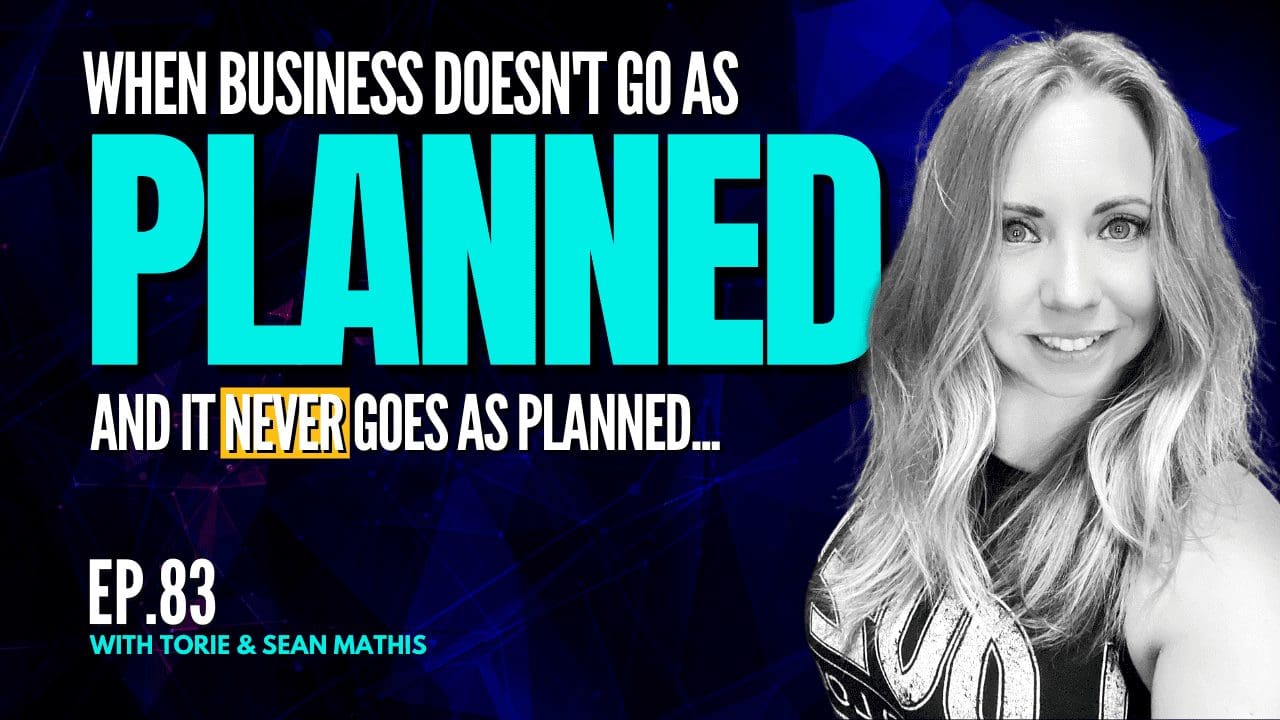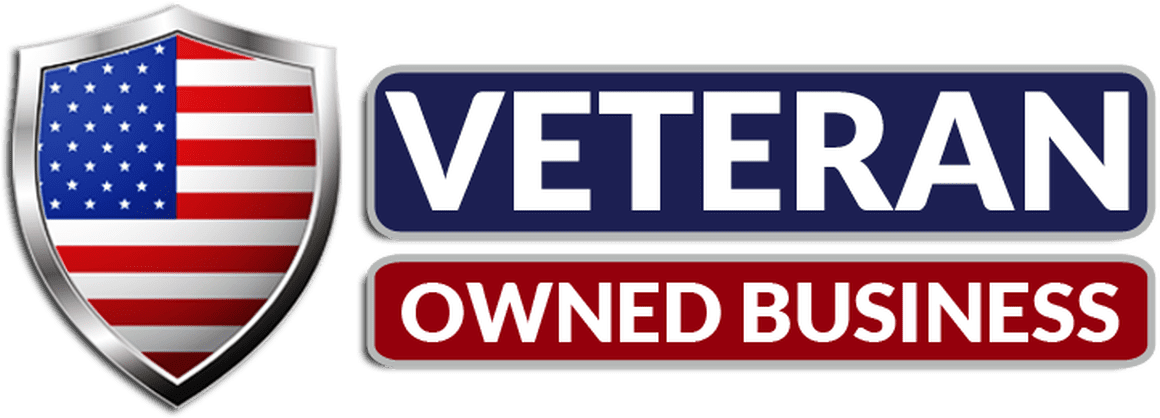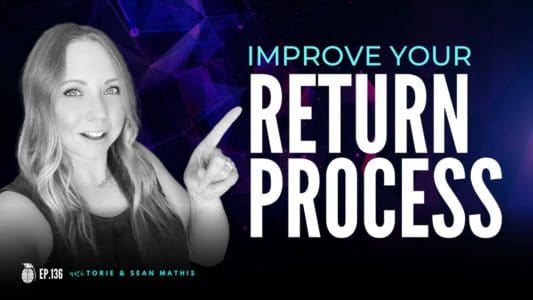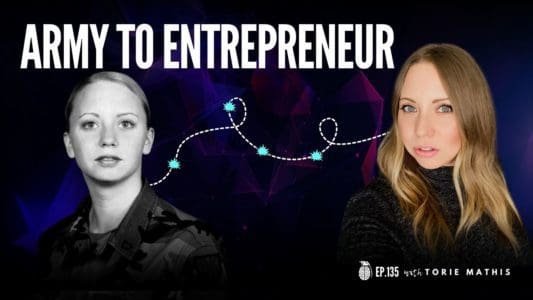Ep. 83 When Business Doesn’t Go As Planned

When Business Doesn’t Go As Planned
This past year, every business experienced unexpected situations, but in business, this isn’t new. No matter how much you plan there are always going to be things that don’t go as planned.
Things change.
People change.
The economy changes.
Maybe it’s you that changes.
As a business owner, you have to be flexible.
In this episode, Torie Mathis and her cohost Sean talk about how to navigate through difficult times due to the unexpected.
Recommended Tools:
Kartra https://toriemathis.com/kartra
WP-Engine https://toriemathis.com/wpengine
Grammarly https://toriemathis.com/grammarly
Listen or watch the full episode below:
EPISODE TRANSCRIPTION –
(transcription is auto-generated)
SAF 83
Torie: [00:00:00] And who would have known that it was going to be 2020.
Hey everybody. What’s up. Welcome to the show. I’m your host, Torie Mathis. And I’m here with the one and only Sean Mathis, founder of Mile Through Time Automotive Museum.
Sean: [00:00:25] How’s it going.
Torie: [00:00:25] Sean had a really big day on this past Saturday. Tell them about your big day, Sean Mathis.
Sean: [00:00:32] It marked the official one year anniversary and our new location. One year of COVID museum. Good times.
Torie: [00:00:41] Sean actually decided to move the museum the year before, so 2019, right? Near the middle of the season, but by end of the year, he was ready to move to a new location which took a lot of coordination and figuring all that stuff out. But you actually started moving things into there the end of 2019, right?
Sean: [00:00:59] No, that was the plan. So the plan to move the museum occurred, I think we were officially going to do it. And by August it was like, okay, we’re gonna, we’re going to move it. And in the original location, the museum was only open in the summertime. So from April and then October 1st we closed the museum down completely because again, it was only me. And after October or after, was it labor day?
Torie: [00:01:26] Yeah, I think you tried to go a couple of weeks after, and it was just never,
Sean: [00:01:29] no, nobody came in. And so I, I stopped and said that the plan was once we knew we were going to have a new location to move to I was just going to close down in April, like normal.
And then you spend that time over the winter giving us until April to then open in the new location.
Torie: [00:01:47] Did you say closed down in April? So you meant you were going to close down in October.
Sean: [00:01:50] Okay. Open by April of 2020,
Torie: [00:01:55] and who would have known that it was going to be 2020.
Sean: [00:01:58] Yeah. And we had so many hiccups before we even.
Got to any of this,
Torie: [00:02:03] But that’s always a pro part of business. And I think some people get so discouraged with even little hiccups or the fact that things could happen. Like things are always going to happen and you definitely had them happen.
Sean: [00:02:15] Yeah. So right off the bat, the museum moved into a portion of the old Clarksville mill, which is a gigantic old mill from the fifties I believe it is or was. And there’s an antique mall there. And we actually were going to take a portion of the antique mall space that wasn’t really being utilized. There’s a, there was like flea market. Like it was literally crap. It was theirs. There was crap.
Torie: [00:02:42] What’s crazy though, is that we had been there two years before and through.
Sean: [00:02:48] If it was the night we stayed up in into COA because Paul Millican from good day Atlanta was coming for a sing in the mall.
Torie: [00:02:56] Okay. So I thought that was a little bit longer. So a year before, before we had even decided to move, we walked into that space. There was a couple of little automotive like there was some gas pumps or something up there and we’d be like, this would be a cool spot for the museum.
Yeah. That’s really good. And holy crap, like who would have thought that, that did end up being the new spot for the museum?
Sean: [00:03:17] Yeah. Yeah. So yeah, so the first thing we had to do was clear some of the crap out. And there’s quite a bit of crap that we had to clear and some of it, we couldn’t actually do ourselves.
And then there was the ceiling we had to actually paint the ceiling black.
Torie: [00:03:33] Oh my gosh, I forgot about this.
Sean: [00:03:35] And that had to be done before. Anything else could be done. And then there was a the guy that owns the antique mall only gave us a portion of this big room, which means he, he built a wall dividing half of the room about half the room.
And so we couldn’t do anything until the room was cleared out. The wall was built and the ceiling was painted and this took months to get this done. Like we, we planned on weeks by within weeks, we’d be able to start, building exhibits and doing things in there.
Torie: [00:04:07] And this just tells you no matter what you plan for you really never know what problems are going to happen.
Like you can’t plan for this stuff at all. You just got to drive forward. No matter what, yeah.
Sean: [00:04:21] And we were doing this on zero budget and then I wound up finding a professional painter that would volunteer, painting the ceiling for us in exchange for, publicity basically when we paid for the paint.
And he wound up just dragging his feet and dragging his feet. And then I finally, I was like, dude, what’s going on. I tried to reach out to him and I found out that he had passed away. And so like w what are the odds of that? And so we, we literally wasted, I think it was two months just waiting on the ceiling to get done that in fact was never going to get done.
And so Truett and I, we actually wound up Doing it ourselves putting scaffolding in there and we knocked the entire ceiling out in two days. And after that, then it became a gigantic mess to clean up the floor. And then after all that, we finally, I think it was January. We finally actually started to do something that would make it resemble somewhat of a museum. We, it, and then we had to start moving in cars and doing a few different things. And it was that, that took a couple of months. And next thing it’s a holy cow, this COVID thing is starting to happen. And any volunteers that we had, they started trickle away and it was down to just Truett and I had to try to do something to get this thing open, but then it was like, do we open? Can we open? I have, is. I didn’t expect any of that. It was not easy to transition.
Torie: [00:05:44] Been really interesting because it wasn’t a normal year. You’re still not even able to see if this is normal. Like all these people that I’ve seen, quite a few people that have opened businesses just like right before COVID hit that. It’s just, you aren’t able to judge or really review or see how things are going because. Things are just still little bit, not normal.
Sean: [00:06:08] COVID actually delayed us being able to open, but because of that, then actually helped us to give us more time to get more of what we wanted done before we opened.
But then by the time we did open it, it was full-blown, People not willing to go outside or go anywhere or any of that kind of stuff. And yet we still had it. We had a pretty decent turnout for the grand opening.
Torie: [00:06:30] Was that was like in June, right?
Sean: [00:06:33] No. It was in may, rarely. Yeah.
First, first week in may. So we did a soft opening is the reason the dates a little bit different. We originally opened officially the last weekend of April. And then we did a formal. Cruise in welcoming car show type deal. The following Saturday. And we wound up having 450 people visit the museum in one day.
Torie: [00:06:56] Wow. That’s pretty amazing,
Sean: [00:06:58] Which I’m pretty sure it was more on the opening day than the entire 2019 season at the other location.
Torie: [00:07:10] That’s quite a change, especially with all the things that were happening. COVID wise. So now that you’ve been in there a year, you’ve been able to get a little bit of feedback, I think that’s a really great thing that every business should do is after a little bit of time, be able to step back and say what’s working.
What’s not what kind of things could we change? Could we tweak? And I know you can’t really say that about the exhibits because Sean moves and changes exhibits all the time. That’s part of what makes Miles Through Time special. It’s part of, the entire marketing and the messaging of Miles Through Time is that it is always changing.
Things are moved exhibits come in and out different cars coming in, in and out. So other than rearranging, what kind of things have you seen that kind of needed to be changed or things that you needed to tweak a bit,
Sean: [00:07:58] so right off the bat when we started in Tacco we had my pops, 59 Cadillac and a couple other random cars. And that was pretty much it. We didn’t even really have any signage. I think you’ve, I don’t remember how long it was, but eventually we wrote a little write-up on each of those, some of the, not even all the cars, then we just stuck them in picture frames because all that shit costs money.
So we’re trying to do what we can with what we have available and all that. And so one of the main things I really wanted to focus on was the museum aspect of the museum? It I I tell people I could fill the building full of people’s cars. I can just shove it full of cars. We could have, probably 75 cars in there, but you’re not going to walk around them.
You’re not going to know anything about them other than they’re in there. And that’s cool for, if you just wanted to store a bunch of cars, but as far as the museum goes, I wanted you to be able to go in there and read stuff and learn something new or something. Interesting
Torie: [00:08:55] Change though, from the first location is that when Sean opened, he had three ideas of what could make money and what the direction was going to go.
And that was a museum, but mind you, he had one car and then, a couple of random cars that, somebody was able to put in there and then vehicle storage and consignment, so selling cars. And so Sean did all of those things to start off with, but you found that some of the stuff didn’t really work or didn’t, wasn’t really the direction that you wanted to do.
So coming into the new location, it’s like you had already decided, okay. Storage is just like it’s a very secondary consignment is no more at all. And we’re moving forward as a museum. A museum a hundred percent. That was a big change. That’s like changing the whole flow of everything and processes and how people were gonna react when they came in.
So you actually had like a. A really big change going into the new location other than just a new location.
Sean: [00:09:52] Is there, there was confusion on do we have cars for sale? Are we just a dealership? Is it a museum? I had people that were like, I’m not interested in the museum.
I just want to see what you have for sale. I’m like, what are you supposed to do?
Torie: [00:10:01] That’s hard when you’re trying to charge people to come in
Sean: [00:10:04] and then if I say I got somebody that’s wanting to look at a car that is for sale, and I’ve got to do that whole car salesman thing. But then I’m still open as a museum with visitors coming in.
And it was very difficult at times. And in the end there was it was not what I wanted to do. And so we got rid of that completely. So as far as the public is aware at Miles Through Time, just change locations, but on the back end, the business completely changed. Like actually closed down everything from the old location and started completely new as a nonprofit. Yeah. And then we got the five oh one C3, which took a little bit longer than just filing a nonprofit, but we got all that done. And so now, like it changes the entire vibe and atmosphere of people going it’s just a museum and I still get calls. You got anything for?
So I’m like, no, It’s a museum like no, nothing is officially for sale in the museum. Now, if an owner of a car takes their car out after their contract is over and they want to sell it. That’s fine, but I’m not going to sell the car inside the museum and deal with any of that kind of stuff.
Torie: [00:11:11] So what were your plans with exhibits?
Cause you said you really wanted it to be have signage and to change that whole atmosphere too.
Sean: [00:11:18] The signage was huge. We were definitely lacking on signage towards the end into co and the original location you had designed. I think three posters like full movie style size posters
Torie: [00:11:30] Were supposed to be informational and tell a story. That’s one of the things that I like about going to museums is I learned like these random things that I would have never known. Plus I learned about the exhibits, which we talk about this a lot is like, why should people care? If you give people a reason to care about things, they’re going to spend more time, they’re going to enjoy themselves more.
They’re going to refer things. No to a friend, they’ll be like, you should go there because Sean has this car in this story behind his grandpa. And once those things. So that was always something that we talked about was like, how do we make people care about these? And then how can we have people walk away knowing something that they didn’t before?
And so I, yeah, we got to start a little bit at the other location, but. Yeah, we really got to go a little further this time
Sean: [00:12:12] And beyond just the content of what the information would be. There was a major investment on display stands and how everything is presented. Not only was it creating the story and the layout, but it you know how it is displayed physically in the museum.
We wanted to get the signs up off the ground so that people could see it easier. We wanted more signage on the walls. And so we’ve got, facts and all kinds of interesting tidbits, just scattered all over the place. And I talked to Torie about it. I’m like, I need somebody to go in there and literally read everything we have to read, just so I can have a baseline of how long that would actually take. Cause my estimate right now, with the amount of stuff that we have in there, there’s no way somebody could read everything that there is on display in a museum in less than an hour. There’s no way.
Torie: [00:13:04] I think it’d be more than that for sure.
Sean: [00:13:06] Yeah. I think it’s wheels through time in Maggie valley. I think they have a thing that says that if you spend two minutes on everything that’s in there, it would take you like two and a half days or something to get through the whole thing.
Torie: [00:13:19] So much stuff. That’s a lifetime collection and it’s amazing if you haven’t been there, like totally worth going and checking out.
But yeah, I could totally see that, and that’s something that people call and they want to know. How long is it going to take me to go through there? That way they can plan their day. They know if it’s worth the drive. And that’s one of those things that you start to get feedback and you’re like, okay, this is a question people are always asking I don’t know, like we really need to find out.
Sean: [00:13:39] I really only know what I observe when I’m there and which isn’t every day anymore. And I’ll watch a watch, a couple come through and they’re in and out and 15 minutes, but I also see that they’re, they. Didn’t really look at anything. They literally glanced and just pass through.
Maybe they like beelined to a specific car.
Torie: [00:14:01] I could see that I could see them going, oh, there’s this car there. And that’s their thing. And without,
Sean: [00:14:06] and then there’s other people that, they’re in there forever. They haven’t even made it around the first corner yet. And they’ve been in there for 20 minutes, so it really all depends. And that’s one of the changes that we did to initially. With the layout was just trying to find a way to slow people down and give them a path because you’d get those people that were only interested in a specific car and they’d wind up making a beeline to it and really just ignoring everything else that may or may not have interested them.
But, once they’ve seen what they wanted to see, it was really easy for them to just be like, okay
Torie: [00:14:36] see, and my whole thing with that, I was like, you got to Ikea them. Ikea, doesn’t let you walk on through. I Kia doesn’t even let you walk on through once you get to the end, they really slow you down.
They really guide you through and make you keep going so that you’re almost forced to look at every little thing and every knick-knack and every room set up. So you’ve got to Ikea them.
Sean: [00:14:57] We have a really cool town built in there that. It has all kinds of neat stuff. There’s a general store, there’s a dry goods store, a bank, have a barber shop and a jail.
And it’s really neat and there’s cool stuff to see inside of these things. And people like if they, they would just walk right through, because what it was you’d have the store on your right, all the storefronts and that’s your aisle. So you’re walking right in front of it, butted up next to these storefronts.
And on the left, you’d have some model T and so if that wasn’t in your wheelhouse of interest, you just kept walking super fast until you got around the corner and saw some of the more modern cars that maybe they were interested in it. So they didn’t even look in and cause what would happen. So I witnessed this firsthand people would come through and they’d say, oh, this is great.
And all this. And I’d be like did you see the the general store, we had all this vintage candy in there, there’s 150 bucks worth of just. Old original candy on display inside this thing. And they’re like, I didn’t even see it.
Torie: [00:16:03] And just ran through the whole like you could have spent 30 minutes in that whole thing, reading everything and checking out like the stories of the model T’s and Truitt built a old Phillips station gas station in there, like a cottage style.
There’s a soda shop. Nobody would even go see any of that stuff. They would just go and go around the corner. Like I, yeah.
Sean: [00:16:23] Design a whole sign that goes with that Phillips 66 station. If you go, like not everybody realizes what they’re looking at. Like it is a replica of the first Phillips 66 gas station.
It’s a relevant exhibit that if they would read it, they go, oh, That’s what I’m looking at,
Torie: [00:16:42] which is cool facts about it. Cause I did a whole bunch of research to make all the signage and things like that. And so even though the Coca Cola, there’s so many cool facts and things like that, that I found that I was able to work into it.
So then you’re like, oh as the car, as the automobile is coming through and as people are starting to get them like. What is that type of era? What is it like for Coke? So the soda shop, what was it like during that time? And Sean has a bank exhibit. So I found stuff about automobile financing and the start of automobile financing and what it was like and how Ford was involved in that and how much it was.
And it was like, if people slowed down, they’d realize that there’s a theme going on there and you could learn a lot. If you’re going to go in there and look at these cars, why not, know more about that era and why it’s relevant. So slowing them down so that they would actually like stop and be forced to at least walk by these signs that all the signage and posters and things that we made. And so after you did the Ikea, how did it go?
Sean: [00:17:39] Most of the feedback was that they absolutely loved it. Because what it would do is it forces them to look at one car. On all sides and then it puts them face forward into the stores. And so they’re able to look straight into it and then they can see the sign that’s right there.
The bank one is one of my favorite ones because not a whole lot of people realize if it was up to Ford and financing, you get a car, like you put layaway stuff at Walmart. That’s what he wanted. You would put a vehicle on layaway once you paid it off, then you got it. It wasn’t until general motors is no, we’re going to help you finance the car, which is how we all know it today.
And that, to me, that’s fascinating and that goes with the bank. So you stare right at it and you can read that stuff and learn that. And you just, and you weave around the corner and you, it takes you on a journey instead of just. Walking through
Torie: [00:18:37] Another thing that happened is that Sean got donated the most amazing collections.
But if that, those weren’t what people were interested in, again, they were just like jamming through them. So it’s hard. Like how, if you have something that is so interesting, that there is a reason to care about, like how do you make people care about that kind of stuff and slow them down and make them.
At least give it a shot rather than I’m not interested in this. I don’t care. And I think part of that is knowledge. Once a little bit about something, then you’re like, oh that’s really cool. And I always think about, and we’ve talked about this before, when we were on one of our cruises, and we went to the art seminar about Peter Mac. And before, when we would see Peter Mac, we’re like, no, like I’ve seen some of that stuff like Beatles cover, and it’s a little gaudy and it’s all these colors. And, but then once we went to the Peter Mac seminar, we’re like, Ooh, like that is awesome. Like knowing the stories and knowing why.
And so bringing that into the museum and figuring out how do I make people care and how do we slow people down?
Sean: [00:19:37] And it really is the same because we would look at the Peter Mac staff and be like it’s from the sixties. Like I can’t relate, it looks like it’s from the sixties.
And so it was be the same thing in the museum. You’ve got people that they’re going for their generation that they’re into. So some of the guys that are 80 years old, they’re looking at the model A’s and that they love that kind of stuff. And some of the younger, they remember their cars from when they were 16 and they were driving around, Camaro’s and challengers and that’s what they want to see.
And then you got the younger, even younger ones that are, doing nothing but watching YouTube that they want to see the Cannonball collection and they’re into the 300 ZX and the newer cars that some of those other guys they’re like, why are those even in here? It all just, it’s all automotive history.
So you just got to. Take it all in.
Torie: [00:20:21] So I think that’s, what’s important though, is that it’s not a model T it’s not a Ford museum, it’s not a model team museum. It’s not a new one. Like we’re really meshing all of these things together that it’s got something for everybody. And it’s super cool.
Tesla came out and to see these guys that are over 60, that lives like never seen him or anything to see them, that they went and test drove him and to like, let get opened the door to that world for them so that they care. You’re getting Truitt it who is in his fifties, getting him to care about the Cannonball cars.
And now he knows about them. He’s in his sixties, getting him to care about like the Cannonball cars and know about that. And now that he knows, like now it’s cool. And now he’s able to share that with other people. Now it’s just like opening these doors. And every time you open these doors and know a little bit about something else, I don’t know, your whole world changes a little bit.
Cause you care a little bit more. You have other things to base them on. Then you start to realize that, oh, that’s what that person was talking about because you know what I mean? Like it starts like this web of, I don’t know, I have knowledge that opens up. Yeah.
Sean: [00:21:22] Yes. And that’s where we took the rest of the museum and we made it, like Ikea, like you are taken through the entire museum.
In one direction and in front of everything that there is to see, and that the hope for that was to eliminate skipping anything. Because that, that was definitely something that. I observed,
Torie: [00:21:41] Which I understand some people are skipping things on purpose, but if you talk to somebody on the other side and you talk about the candy and they were like, oh, that’s cool.
I would have been interested in, but they didn’t even see. It’s it’s unintentional, skipping. Like they didn’t even realize it because they were just guided to go through so fast.
Sean: [00:21:56] We’ll see. And I know like when we visit other just general museums, I can’t stand it when it’s just, there’s no path,
Torie: [00:22:04] Then you don’t know if you’ve seen some parts of it.
Are we supposed to turn around and go back through them? Yeah.
Sean: [00:22:09] If it can keep me going in a line, just weave me, however, it needs to be weaved, but at least then I know I’m being placed in front of everything the museum has to offer it’s then up to me, if I find interest in it and want to learn something more about it, but at least I was.
I was presented to it, and that’s what we wanted to make sure that we were trying to do for people was to at least put them in front of what it is we have for them to see, and I think it was I think it’s been a good thing for most people to go in there and do that.
And then we wound up, I wound up having an issue with people, finding the exit.
Torie: [00:22:45] Mind you, how many square feet is it? It’s 10, about 10,000 square feet. And people are getting lost. Can’t figure out how to get out. Yeah.
Sean: [00:22:52] Yeah. You cannot go out the same way you came in. Which is part of our security process to keep everything safe.
Torie: [00:22:59] And that’s how most museums and things like that are like, or like the zoo, you exit through the gift shop. It’s a different place than you.
Sean: [00:23:05] You do it at the museum, you exit through the gift shop. And there’s always been an exit sign on the exit door.
Torie: [00:23:11] It’s a chunk, it’s another exit sign. And then he gets a flashy sign.
Sean: [00:23:17] Yeah. So now there’s an. An exit sign, like emergency accidents. That’s above the door. Then there is a curved pointed exit sign. That’s up high that pointing to the exit that’s now lit up and flashing. And then there is, and it’s in colors that change. And then there’s another spotlight in colors that flashes and points on the exit door as well.
Then we put exit signs, like stick floor stickers throughout the entire path, just to let people know. You’re like, you’re going in the right direction. You’ll find your way out.
Torie: [00:23:49] And then we were at Gibbs gardens, which is a Japanese garden. That’s, here outside of Atlanta. And when we go, they give us like a map and like this, all this information.
And I’m like, oh my gosh, Sean, I didn’t even think about it. We can give them some type of guide and be like, here’s a map. Here’s where it is. Here’s where the entrance is. Here’s where the exit is. We made a home welcome guide. And I didn’t, but at least it’s just another step like this wasn’t working that wasn’t working.
So how do we adjust some things and give them another reason to care because now we’re giving them some information and we’re helping them exit.
Sean: [00:24:27] And then the other thing was initially when we did that Ikea path, that’s pretty strict on it. Like you were going to go this way until you get out.
What happens is people need to go to the bathroom. Or that they, whatever, they forgot their phone in the car or they’re volunteers. And they’re like, I, and they’re old and they don’t want to walk through all that stuff. So I wind up having a secret passages, they’re not secrets.
They’re like they’re wide enough for somebody to pass through, to cut through all the weaving of the maze. But, I don’t want the normal visitor to go that way. I want them to follow the arrows on the ground and go see everything. And now there’s a map that they get when they purchase their ticket.
And it also tells them that. It’s just, it’s little thing after little thing of just slowly going and going let’s try this, let’s do this. Let’s improve this.
Torie: [00:25:16] And even with the welcome guide, we really were like, how many should we print? And we talked about how many ways you print and how many it would take for this thing.
It’s a first draft, like really, let’s not print 9 million of them because let’s change. Let’s see what happens, get some feedback and then change it. And I think that’s super important to do don’t go permanent all in with everything. Because how many people have 9 million brochures that they never use, they printed them for one thing and they’re like, oh, it’s a deal. If we print 5,000 and then they use a hundred of them so we’ll know how many did you end up printing
Sean: [00:25:50] a thousand?
Torie: [00:25:50] Which, where are you at now?
Sean: [00:25:52] We’re down to 20 left.
like 900 left.
Torie: [00:26:05] Okay. It’s only been a couple of weeks, so you know that just to get us through right
Sean: [00:26:10] less than that. Cause last Saturday we had 83 people visit just on Saturday and every one of them got one of those and then. The Saturday after that we had 53 people visit. And so the Saturdays are our biggest days.
Torie: [00:26:22] So just between a couple hundred down there.
Sean: [00:26:24] Yeah. We’re getting close to halfway already.
Torie: [00:26:27] It’s going to give us enough time that we can adjust what we need to, we can correct the stupid spelling error that’s off the back because I don’t talk very well. I told Riley, if you can find the spelling mistake, I’ll give you five bucks
Sean: [00:26:43] in fact, you can make a whole game out of visiting the museum and looking at all the spelling errors all over the place. They’re there. It doesn’t matter.
Torie: [00:26:54] Oh my gosh. The first sign that we made was when the ad like the rules,
Sean: [00:26:59] which is still on display in the museum right there. When you first enter,
Torie: [00:27:02] oh my gosh. Like we can spell. But you get so involved. I get I get the design and I look over it and I spellcheck the damn first sign that we said it said something about it.
If you have a problem, talk to the manager. It says manger. It says go and talk to the manger. Okay.
Sean: [00:27:23] No. And in the, now in, in the original location, it was right on the wall right behind me. Nobody ever said anything.
Torie: [00:27:30] Yeah. And so the stupid brochure, the welcome guide, instead of saying purchase, it says per case on the back.
It’s okay. But we only printed a thousand and so we’ll end up fixing it and that’s fine. It’s totally okay. That it has. One little mistake in it, but that allows us to make changes, to make it a little bit better, to fix it, to tweak it. And all those states have to do it. It seems when we go into some museums and stuff, it looks like it’s been sitting there for 20 years.
I don’t think they’re doing these types of things. And I hope with anybody’s business that they’re making these little tweaks, cause it’s a little tweak here and a little tweak there that a little tweak that ends up being like. Big changes over time. I don’t know if people are like, they want to make big changes.
And so since they can’t, they make no changes,
Sean: [00:28:15] yeah. And see that to me, that’s beyond, being able to meet people and trigger all these stories and all that stuff that makes, having a museum itself worth doing. It’s fun from a business owner entrepreneur standpoint to, to be so fluid with it.
Cause I literally have. No experience beyond the experience, I’ve accumulated doing this. So I’m I’m OJ team, all this I’m on the job training the entire thing. So I only know what I know. So if somebody who has an idea, Torie comes up like w like the welcome guide that was literally was it one day you told me one day you designed it.
The next day we sent it to print and we had it at the museum. Inaction
Torie: [00:28:59] within a week. Yeah. Cause it was like something that I was like, I didn’t even think of this. And Sean’s we couldn’t have thought about it. Cause it wouldn’t have made sense before. It was like, it’s the perfect time to actually make that happen, with the OJT thing.
It’s funny. Cause I’ve been in business for myself for a lot longer than Sean has. And so Sean, every once in a while, I’ll say I don’t know how to do that. I’m like, do you want me to shook things like that? I didn’t know how to do it either. I still, every day, like I come up with stuff all the time that I’m like, I don’t know how to do this.
Figure it out. Probably screw it up. Probably spell something wrong, whatever, but that’s the only way that you’re going to learn. And so I agree, like keeping things a little bit fluid, not being super rigid and structured man, that has a way to go because that’s how you’re going to improve. It’s we always talk about, we see people that do these major renovations to their house only right before they left.
What the hell are they doing this whole time? If you could only be like, and these are major things like. Why did you not care while you were living there? Like why would you only do improvements when you’re going to leave it, but your business too, like you can constantly just fix, just tweak, just make these little teeny changes a little bit better, a little bit better, a little.
Sean: [00:30:02] And if it goes the wrong direction, switch it back, do something different. Again, try something else
Torie: [00:30:10] with the welcome guide too, that we didn’t put in there. The pin Stripe guy. Yeah. Cause we were trying to think of, we wanted to focus on a couple of things. Like again, how do you make them care? So let’s pick out some exhibits.
Some that may not be there forever. And like, how do we make them go, oh, there’s these five or six things like go and look for those things. And then you care about those things and you might see some other things.
Sean: [00:30:32] And so mark also known as top hat is a legendary. Pinstriper across the nation and he is a local legend.
And so his he’s passed away and his daughter actually came into the museum and set up the exhibit that we have that, pays homage to him.
Torie: [00:30:50] And even did she put some new lights or something down there? Because there was part of it that I was like, I’ve seen this, but I’ve never even noticed that there’s like all these paint cans and things like his whole little areas all set up.
It’s pretty cool. And again, like if. People didn’t know that it was there, why it was there. It’d be really easy to just glance over and be like, oh, paint cans.
Sean: [00:31:07] Yeah. It’s one of those things that like, if you weren’t reading stuff and you just look, what is this?
Torie: [00:31:13] Even the train. So Sean has this half size train and it’s called the general. That was in a movie that was in the same county that the museum is in right. Habersham county. So it was, the movie was in there from the.
Sean: [00:31:27] Fifties, it’s called the great locomotive. Chase is a Disney movie.
Torie: [00:31:32] And so this, if there’s a half scale model that somebody has made now, you’re like, okay, so what this thing is made out of wood, the whole entire thing was carved from wood.
It is a half scale train. Like it is amazing. There are all these wood piece it like like you would logs that you would pieces logs, that you would put in the fire to like make the train work. And he’s carved all of these too. Like it’s not just chunks of wood. They’re all hollow and everything.
And You could easily go, oh wow. A train. But then if you knew the trains from a Disney movie from the fifties, and it was actually filmed here. And a lot of people apparently really liked the movie because the people that are of that era that remember it, think it’s super cool.
Sean: [00:32:13] And it has historical significance. The movie was also based off of something that really did happen. So that, there’s a lot of cool aspects to it beyond it. Just oh, there’s a half scale train. I think there’s more, you can learn from it.
Torie: [00:32:29] Yeah. I think there’s things with that, with everything it’s easy to not like, because it, you think that oh, like everybody already knows that or whatever.
Like you really have to tell people what these things are to what makes it special because otherwise, oh yeah, the train, like big deal, but it’s actually super cool. If you actually stopped and took a look at it and you cared about it,
Sean: [00:32:49] yeah. And even people I’ll see them say they visually, they look like they’ve got interest in whatever it is they’re looking at, but I can see they’re still not reading anything.
So I have people come over and they’re looking at this 77 Lincoln continental we have on display in there. And, I can tell they’re like, oh, that’s a big car. It’s really nice. And I’m like, that’s Jimmy Carter’s secret service vehicle. It’s a, one-on-one only one they’ve ever made.
In fact, they didn’t make convertibles in 1977 and it blows, those are mine. I mind you, it says all that right there, but they’re not reading it. They’re just like, oh, that’s a cool big car. And there’s so much more there to it. So at least I can regurgitate that stuff and tell them that kind of thing.
Torie: [00:33:32] Anything else that you’ve noticed any feedback that you’ve gotten now that you have one year in know, things that you have that you think could make it better, that you got planned or
Sean: [00:33:41] bottleneck on space again. So now it’s just it’s we need more space and the space is it’s there as soon as we can get to it.
And that is going to be the next phase. And once we can do that’ll triple the size of the museum and then it’ll change the entire layout again. That’ll be the next level of like really being able to ramp up the museum aspect like that. That’ll take our vision of what we want to do and really be able to put it into action.
Torie: [00:34:09] You gotta do something with that beginning part too. It needs a little love.
Sean: [00:34:13] Now there’s still, there’s all kinds of stuff we still need to do in the space that we have. It’s just, it takes time and it takes money and we have to, be able to generate that money, to do all these things. So the more visitors we have, the more donations we get the quicker we can start implementing some of these newer things
Torie: [00:34:33] You just said too, because Sean’s got a a visitor book in the front, you said.
Filled it out completely. Like we need to get you a new one.
Sean: [00:34:40] I think there’s one or two pages left. So yeah. We’re going to need to do that and then same with the pins for the next. Yeah.
Torie: [00:34:45] So Sean has a big map on the wall that like you could grab a pin and then put it where you’re coming from.
And that way we could get a visual representation over time of where everybody’s coming from,
Sean: [00:34:56] Which is all over. They come from all over the place, which is pretty neat.
Torie: [00:35:00] It’s pretty neat. Cool. So hopefully if you’re in the area, like we would love to have you come out and visit the museum.
Sean, you want to tell him how to get in touch with the museum where you’re at.
Sean: [00:35:12] So Miles Through Time is on social media. All the big social media is you can just search Miles Through Time. Obviously the website is also available for you to go to, and that is Miles Through Time.com
Torie: [00:35:23] And the museum is on grant street in, I didn’t know
Sean: [00:35:29] If you want me to tell you the address. It’s 583 Grant street, Clarkesville, Georgia.
Torie: [00:35:33] And it is within 20 minutes of the third, most popular little town in Georgia. That gets visited pretty cool area. So hopefully you can come well, I check it out.
Sean: [00:35:44] It’s only an hour outside of Atlanta.
Torie: [00:35:46] If you liked this episode, we would greatly appreciate it. If you would share it with somebody that you think would get some value out of this, and we will see you on the next one. Yeah.
You want to get smart tools to build your business go to getsmartaf.com.
About Digital Marketing Expert Torie Mathis

Torie hosts SMART AF, a show for non-techy entrepreneurs looking to grow their business, with her husband Sean and is the creator of SMART AF Magazine. Learn from Torie at the Smart Arsenal and on her channel.
Hi! I'm Torie!

You don’t need crazy tech skills, buckets of cash, or dedicated staff to market your business. You don’t even need a lot of time.
What you need is to be SMART.
GET SMART AF
DELIVERED TO YOUR INBOX
from your Digital Marketing Coach Torie Mathis!
Let's get SMART!
Let's Connect!







 I help entrepreneurs learn digital marketing.
I help entrepreneurs learn digital marketing.

